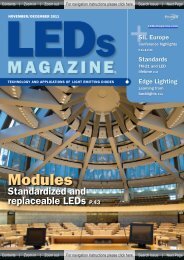Zoom In - Beriled
Zoom In - Beriled
Zoom In - Beriled
- No tags were found...
You also want an ePaper? Increase the reach of your titles
YUMPU automatically turns print PDFs into web optimized ePapers that Google loves.
Previous Page | Contents | <strong>Zoom</strong> in | <strong>Zoom</strong> out | Front Cover | Search Issue | Next PageABE FMaGSfundingprogramsCITADEL key parametersPROJECT BUDGET: 1.5 million Euros (~$2M)FUNDING: ADEME (French Environmental Agency)START DATE: 9 February 2009DURATION: 3 yearsMORE DETAILS: ledsmagazine.com/news/6/2/14French CITADEL project looks atLED lighting in buildingsThe research will help French laboratories to qualify commerciallyavailable LED lighting products, writes CHRISTOPHE MARTINSONS.Currently the field of lighting is in the midstof a technological revolution, unique in itshistory, with the advent of new generationsof systems based on LEDs. Significant progressachieved by semiconductor specialistshas led to robust and compact light sources,offering attractive control capabilities. <strong>In</strong>laboratory conditions, white LEDs reachluminous efficacies greater than those ofmost lamps used in lighting, and, above all,they exhibit far greater life expectancy. LEDsare therefore considered, as they well shouldbe, as a major component in future solutionsfor interior and exterior lighting.Despite all these advantages enthusiasticallyput forward by the semiconductorindustry, it is commonly reported that theuse of LEDs in buildings is slowed down by acertain number of complicated problems. Therequirements for successful building integrationare very specific and often unrecognizedby LED makers. Several constraints occur inbuilding applications: visual comfort, performancesustainability over time, real-lifeexpectancy, total cost assessment, and compliancewith building standards and codes.LED lighting products should be ableto fulfill the fundamental requirementsdescribed in well-established EuropeanCHRISTOPHE MARTINSONS is head of theLighting, Electricity and ElectromagnetismDivision of CSTB, St Martin d’Hères, France.Email: christophe.martinsons@cstb.fr.lighting standards such as EN 12464-1 forindoor lighting of work places. For instance,LEDs should provide the required “qualityof light” that is associated with a minimumcolor rendering index and a range of colortemperature.Glare is a critical phenomenon often associatedwith the use of LEDs. Satisfying conditionsof visual comfort cannot be reachedwhen sources of very high luminance are inthe field of view. This is the case for “naked”high power LEDs with luminance levels measuredin millions of cd/m2 (nit). Naked LEDsor LED arrays (products with insufficientoptical design) may present visual risks.Safer products with better optical designscan still exhibit discomfort glare, which isnot very well characterized by the standardUGR (unified glare ratio). Its calculationmethod fails when applied to a multitude ofsource points such as an LED array.LED products are very thermally sensitive.LED junction temperature critically affectslight output and color, as well as life expectancy.Many LED products are designed tobe integrated in walls, ceilings or floors, andthese elements are often very well insulated(acoustically and thermally). This meansthat heat generated by LED products mightnot properly dissipate. Generated heat caneven endanger the integrity of building elements,causing for example cracking ofmaterials or deterioration of sealants, allowingmigration of humidity.CITADEL consortiumThe CITADEL consortium is formed byseveral public research laboratories, publicinstitutions and a major lighting company.The partners have complementaryskills and each specializes in a key aspectof LED lighting and building integration:CSTB: Centre Scientifique et Techniquedu Bâtiment (Centre for Building Scienceand Technology), Grenoble, France. Projectleader. <strong>In</strong> charge of photometry ofluminaires, building integration, agingprotocols, risk analyses and effective lifeexpectancy, life cycle analysis.LASH: Laboratoire des Sciences del’Habitat (ENTPE and CNRS), Lyon. Buildingintegration (visual aspects), light qualityindices, photo-realistic simulations,experiments on subjects, total cost ofownership.CEA-LETI: Grenoble. Microelectronicsexpertise on LEDs, degradation and breakdownsmechanisms of chips/packaging.LNE: Laboratoire National de Métrologieet d’Essais, Trappes. Traceability of measurements,design and construction of highpower LED standard devices.LAPLACE: University of Toulouse andCNRS, Toulouse. Expertise on electronicsaspects of LED lighting products (powersupply and controls). Accelerated aging ofLEDs and LED modules.Philips Lighting, Luminaire division, Miribel:Philips Lighting is committed to providingthe CITADEL partners with therequired product data (bill of materials,industrial processes, etc.) necessary to performlife-cycle analyses and environmentalimpact studies. ◀Footnote: CSTB, LNE, LAPLACE and Philips areactively involved in national and international normalizationactivities (AFNOR in France, CEN inEurope, CEI and CIE worldwide)12 APRIL 2009 LEDsmagazine.comPrevious Page | Contents | <strong>Zoom</strong> in | <strong>Zoom</strong> out | Front Cover | Search Issue | Next PageABE FMaGS

















